You might have questions about a Golden Retriever’s diet, exercise, and sleep schedule before adopting one. Those things are all relevant to you as your dog’s primary caretaker. But in addition to being its caretaker, you are also its trainer. And to fulfill that role, you need to know the Golden Retriever puppy training schedule.
A Golden Retriever puppy training schedule should begin at two months old as soon as you bring your new pup home. Start by teaching him that you are the leader. From then on, teach 2-4 commands per month, starting with simple gesture-triggered cues, then advancing to more complex and word-triggered commands.
In this article, you’ll find out all you need to know about training your Golden Retriever, starting with the initial exercises. I will outline the entire training schedule alongside what to expect at each stage of your Retriever’s development.
You’ll learn what kind of training your puppy needs at two, three, four, five, and 6 months old. Training schedules from the 6-month mark to adolescence and adulthood are also covered alongside information on how to:
- Start training early
- Teach your dog to follow you and understand that you are the leader
- Socialize your Golden Retriever at an early age
- House train your pup by 4 months of age
- Train your pet to be compatible as a long-term companion
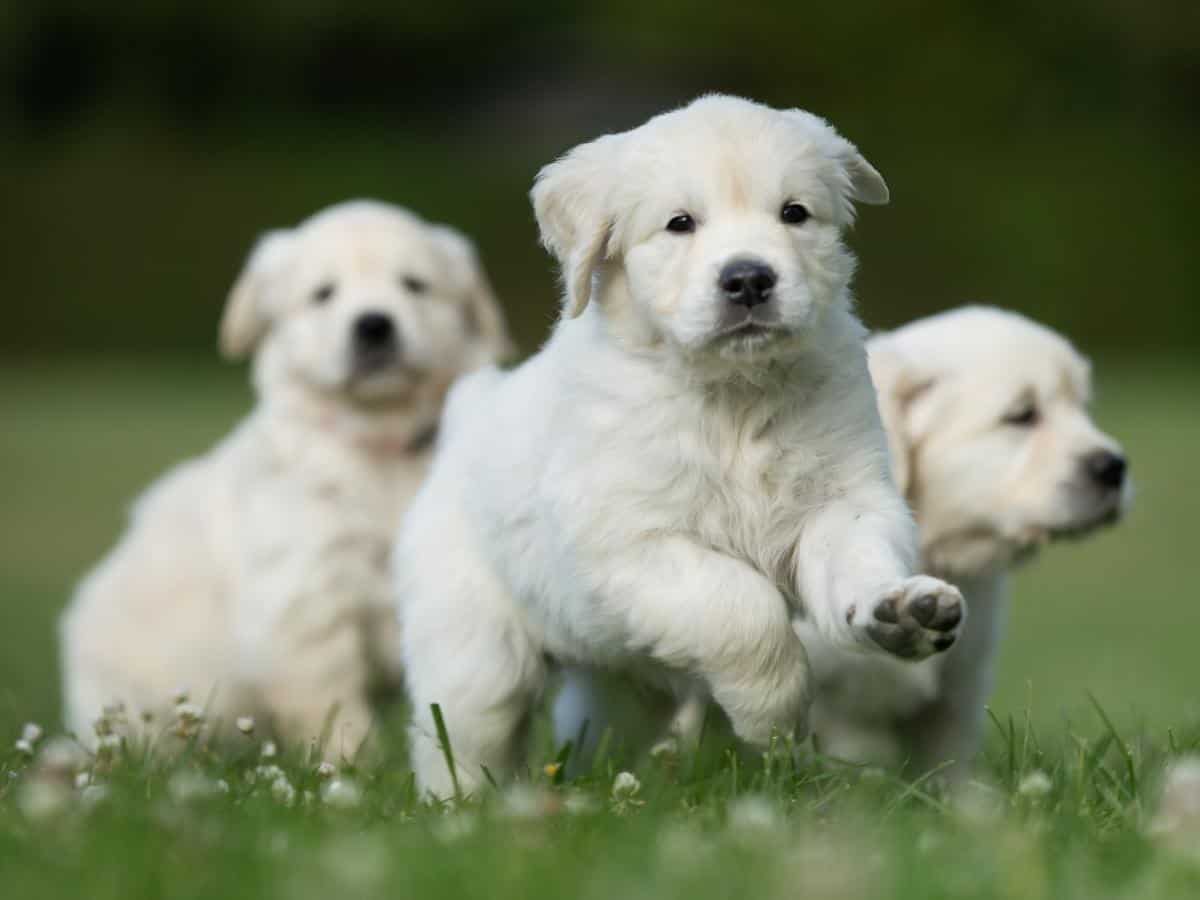
| Age of Puppy | Golden Retriever Puppy Training Schedule: What to Teach |
| 2 Months | Set Initial Anchors Establish Authority Early Socialization Potty Training Bite Inhibition Teach Patience |
| 3 Months | “Sit,” “Down,” and “Stand” Heel Recall Increase Socialization Target Training |
| 4 Months | Sit and Stay Fetch Continue Potty Training Leash Walking |
| 5 Months | Reinforce Previous Training Contain Energy |
| 6 Months | Increase Exercise Start Advanced Command Training, e.g., “Leave it” and “Wait” Complete Potty Training |
| 7 Months | “Take it” “Speak” |
| 8 Months | Recognizing Commands for Different Places “Quiet” |
| 9 -18 Months | “Spin” “Roll Over” “Go Ahead” Other Tricks, e.g., “Crawl” and “Wave” |
Before we get into the Golden Retriever puppy training schedule, please bookmark this post, as it will remain relevant throughout your dog’s early life. With that out of the way, here’s the first stage.
Are Golden Retriever Puppies Easy to Train?
The ease of training dogs varies across different breeds and the age at which they are adopted. Retrievers are typically released two months after birth and ready for training. Fortunately, they are pretty observant and intelligent, so training them isn’t as much of a chore.
Golden Retriever puppies are easy to train because of their high social intelligence, loyalty, and desire to please; they can understand commands and positive consequences in the first few weeks. However, if you do not teach them early on, you may need to work harder to get them to unlearn bad habits.
We must remember that Golden Retrievers are acclimatized to working with people and are definitely people pleasers. They were bred as hunting dogs to retrieve shot-down waterfowl and are still used today as gundogs by sportspersons to retrieve game birds. They are also used as service, therapy, and search and rescue dogs.
While training a Golden Retriever is easy, you have to start early. If the dog misses the early portion of the training, the later stages draw out perpetually.
A dog’s intelligence is on par with a 2-year-old child, so older dogs, rescues, and untrained Retrievers can be harder to train, as they can’t connect reward to action, command to action, and authority to owner quite as quickly.
What Age Should You Train Your Golden Retriever?
By now, you know the dangers of being too late in training your dog. But what if you are too early for the party? Is there such a thing as “too young to train” when it comes to Golden Retrievers? Not if you go by the standard release time. The average breeder releases a Golden Retriever at 8 weeks old.
You should train your Golden Retriever at two months old because, by that stage, he has grown enough to take cues and is sufficiently self-reliant not to need his mother to survive. He will have already learned canine behaviors by interacting with his mother and littermates, but now he can continue to learn by association.
Initial training should be kept light. As mentioned in the table, it is simply a period where you establish your authority as the source of commands and rewards. You can even go 2 weeks without giving any proper training to your freshly-released pup without impacting his progression. However, the 8 to 10-week period from release to assimilation is important.
It is trickier when you’re thinking about training a puppy that your family dog has given birth to. Don’t start teaching the pup the moment you see it walking around.
Although the puppy can seem self-sufficient at 6-weeks old, if you’re two weeks early, you may confuse or frighten him by overloading him with stimuli before he’s ready to make the correct associations. A traumatic experience can have a negative and counter-productive effect during this period.
Read further if you:
- Have a Golden Retriever older than seven weeks (or plan to get a puppy)
- Want an approximate schedule for training your pup
- Wish to train a dog using positive reinforcement and ethical training methods
- Want to commit to 1.5 years of casual dog training
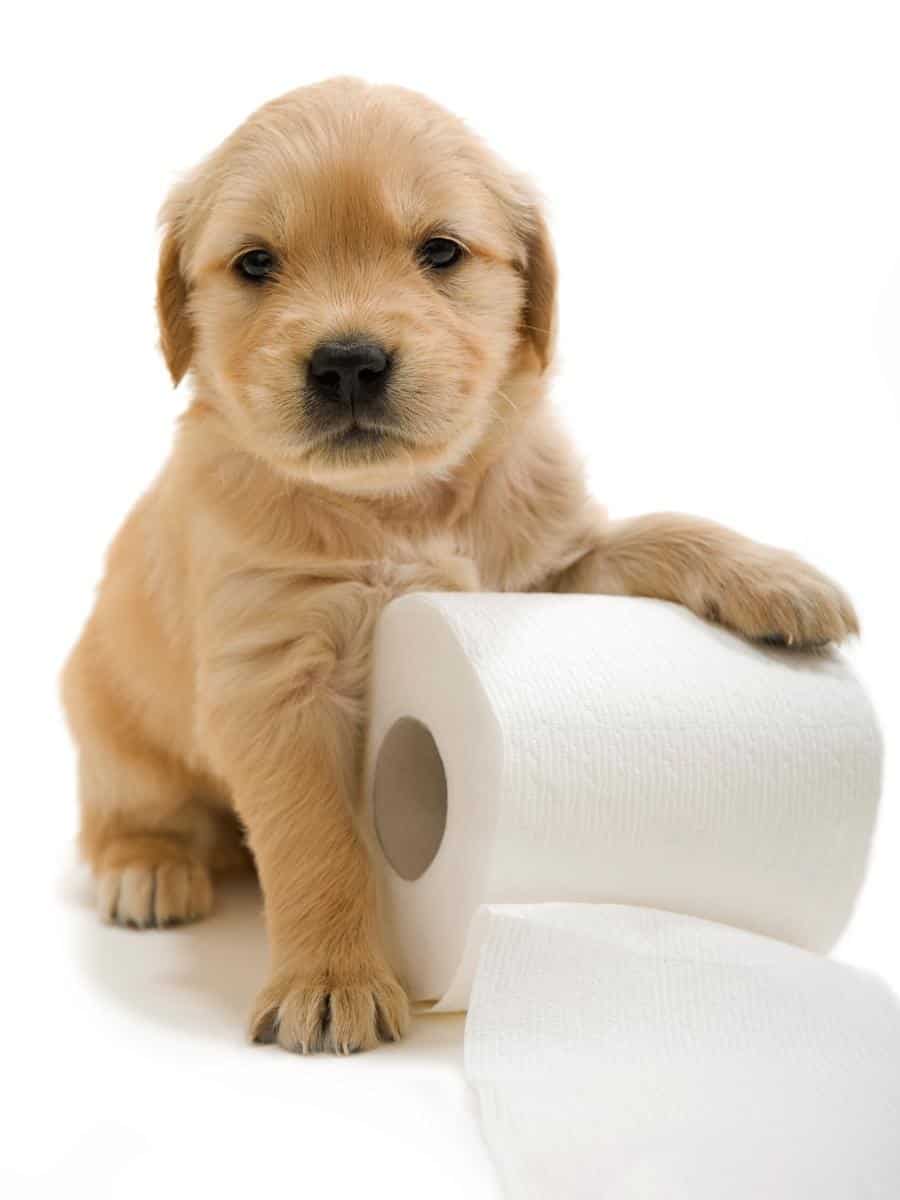
How to Train a 2-Month-Old Golden Retriever Puppy
When a Golden Retriever is 8 weeks (2 months) old, he is ready to be separated from his mother. At this point, you have to train your puppy to see you as an authority figure. Don’t assume authority and start commanding him. Instead, get him to follow you around and notice that you’re his sole provider.
Moreover, the puppy can only form the most obvious associations between command, response, and consequence, so it is crucial to adapt your training strategy accordingly.
Set Initial Anchors
When training a 2-month-old Golden Retriever puppy, you should wait till he’s doing something right and then produce a stimulus that he can naturally link to the wanted activity. For example, you can start clapping if your pup runs toward you.
Once he realizes that clapping and running toward you are linked, you can clap, and he will run toward you. However, you can’t expect the latter to happen at this stage. For now, notice the following and set distinct anchors for each.
- Following you
- Eating food / consuming a treat
- Assuming a natural heel position (likely if there’s another dog in the house)
Initially, the anchors need to be very distinct and different. Each anchor has to be hard to confuse with every other anchor. Clapping, for instance, is an anchor that can be confused with snapping your fingers. But it is hard to confuse clapping with whistling.
“If you use words as commands at this point, make sure to inject widely different tonalities to make the commands very distinct.”
“SIT” and “RUN” might sound different for a grown Golden Retriever, but a young puppy might classify both as “mouth sounds.” That’s why the above anchor suggestions are distinct.
Establish Authority
You must establish yourself as his guide at an early phase in your dog’s training. This melts a lot of the resistance as you train your pup to understand and respond to more complex commands. Therefore, the first step should be encouraging your Golden Retriever to follow you. As you may know, dogs evolved from wolves, and wolves follow the pack leader (usually a parent).
Don’t assume that your puppy will follow you around perpetually without an incentive. Delaying gratification is easier for grown dogs. Young puppies get tired too quickly and spend most of their time sleeping. So if your puppy follows you, reward him with affection, hugs, and appreciation.
Don’t take abrupt turns in the first week of your puppy’s training. You need to build a positive reinforcement loop and let your dog establish a connection between following you and receiving a pleasant experience.
When your puppy knows that following you results in rewards, you can make the act of following you slightly more challenging. Things you can do may include sharp turns and sudden changes of pace. You’ll notice that he will turn and even leap behind you.
Watch This Gorgeous Golden Retriever Pup Being Trained For The First Time…
Lower Socializing Barriers
Golden Retrievers are the definition of social beings. However, if they don’t get enough social exposure early on, they might become slightly introverted. Still, their appearance and the love they receive can keep them from becoming completely asocial. But why make socialization difficult when you can facilitate it early in their lives?
Visiting friends and family is one way to go about it. You can also spot a dog park and carry him there. Remember that your pup is still learning to follow directions and walk with you. You cannot expect him to cover long distances. Unfortunately, many pet owners let their dogs’ physical limitations turn into social limitations!
Golden Retrievers are bundles of energy, and it would take living in a castle for one to become agoraphobic. They will likely take any chance to go out, so you don’t need to worry about your dog becoming a recluse. Seeing the outdoors as soon as they are ready to take block-long walks is healthier for their social development.
Start Potty Training
You might wonder how long you have to wait before your Golden Retriever puppy is ready for potty training. Quite simply, your Retriever is ready for potty training the day you bring him home. If your puppy isn’t learning to poop in a specific area, he is learning to poop anywhere he wants.
It helps to make the area of your yard where the dog must go look visually distinct so he doesn’t learn to poop anywhere in the yard. Cordoning it off and adding a small fence can help him identify it more easily.
Next, you need a potty training schedule, such as first thing in the morning, after mealtimes and play, and hourly for young pups. Moreover, many owners use dog crates to help with house training and I highly recommend you do this too.
Watch This Cool Video How To Potty Train Your Golden Retriever…
Discourage Biting
If you’ve read other articles on my blog, you probably know that I am against punishment-driven training. I believe negative reinforcement doesn’t work long-term and aversive training even affects dog welfare. The earlier you discipline your Golden Retriever, the less harsh you need to be with him as he grows up.
Biting is one of the behaviors that incur severe penalties for dogs. Golden Retrievers, fortunately, develop a soft mouth and are less likely to administer harsh bites. Still, nibbling must be discouraged so that kids, other pets, and your friends can be safe around your puppy.
If you have ever given silent treatment to your spouse, you know it takes intelligence to know that you are in a timeout. So a timeout for a 2-month-old Retriever might not be the right punishment because he might not understand why he is in one.
“But if he bites you during an activity and you terminate the game, he will understand that biting has negative consequences.”
This can be a little tricky because if he bites you while you’re not playing, you can’t do much to discourage him aside from showing that you’re hurt. It takes patience because you must ignore the bites and the nibbles until you’re in the middle of a positive act.
Often, an untrained Retriever puppy might snatch at a treat. After that, you can withhold the second treat and close off your body language.
You can act hurt and convey that your dog’s actions have affected you. Let out a high-pitched yelp such as “OUCH!” and then redirect the biting by offering a chew toy.
Follow up using positive reinforcement by rewarding the correct behavior with a treat. Your Golden Retriever will quickly learn that displaying good behavior reaps nice things.
Puppies need to learn their bite inhibition (soft-mouth) by continuing the excellent work their mother and siblings taught them. Don’t worry; Golden Retrievers learn this skill pretty quickly as they were bred to retrieve downed game birds with a soft mouth and not damage them while retrieving them for their hunter.
Here’s an Awesome Video all About Puppy Biting Training…
Teach Patience
You must use your best judgment when training your dog to be patient. Generally speaking, your Golden Retriever will be mature enough to learn self-control by the tenth week.
Read more: You can learn a ton more about training an 8 Week Old Golden Retriever in my beginner’s guide.
How to Train a 3-Month-Old Golden Retriever Puppy
Once you have established your authority and set initial anchors, it is time to progress the training of your Golden Retriever puppy to the next stage. Four weeks of light training is sufficient for setting anchors and establishing associations. That makes the 3-month mark ideal for slightly more complex commands.
Teach the Heel Position
While your 3-month-old Golden Retriever puppy will initially follow you, if you adjust your pace, you’ll soon have him walking alongside you at the heel position, on your left-hand side, without a leash, harness, or fear of punishment. You can use a clicker or a whistle to teach your puppy to assume the natural heel position.
You will have to use the “Heel” command as he walks in the heel position. At first, the heel position will naturally occur rarely, and the dog won’t hold it. He will regress to walk behind you. But if you’re walking in an area he is familiar with and gets rewarded immediately when he falls in the heel position, he will be more comfortable walking alongside you.
Train Your Dog to Assume Positions on Command (Sit, Down, Stand)
When your Golden Retriever puppy is 3 months old, he is mature enough to sit, stand, or lie down on command. He already knows how to sit and stand, and you have to use the same method you used for the heel position and command to teach your Retriever how to sit or stand on command.
The method is simple. Wait until your dog sits, and say the word “sit” while giving him a treat. The same applies to other position commands. Since your Retriever can tell words apart, he can go into different positions based on the words you say.
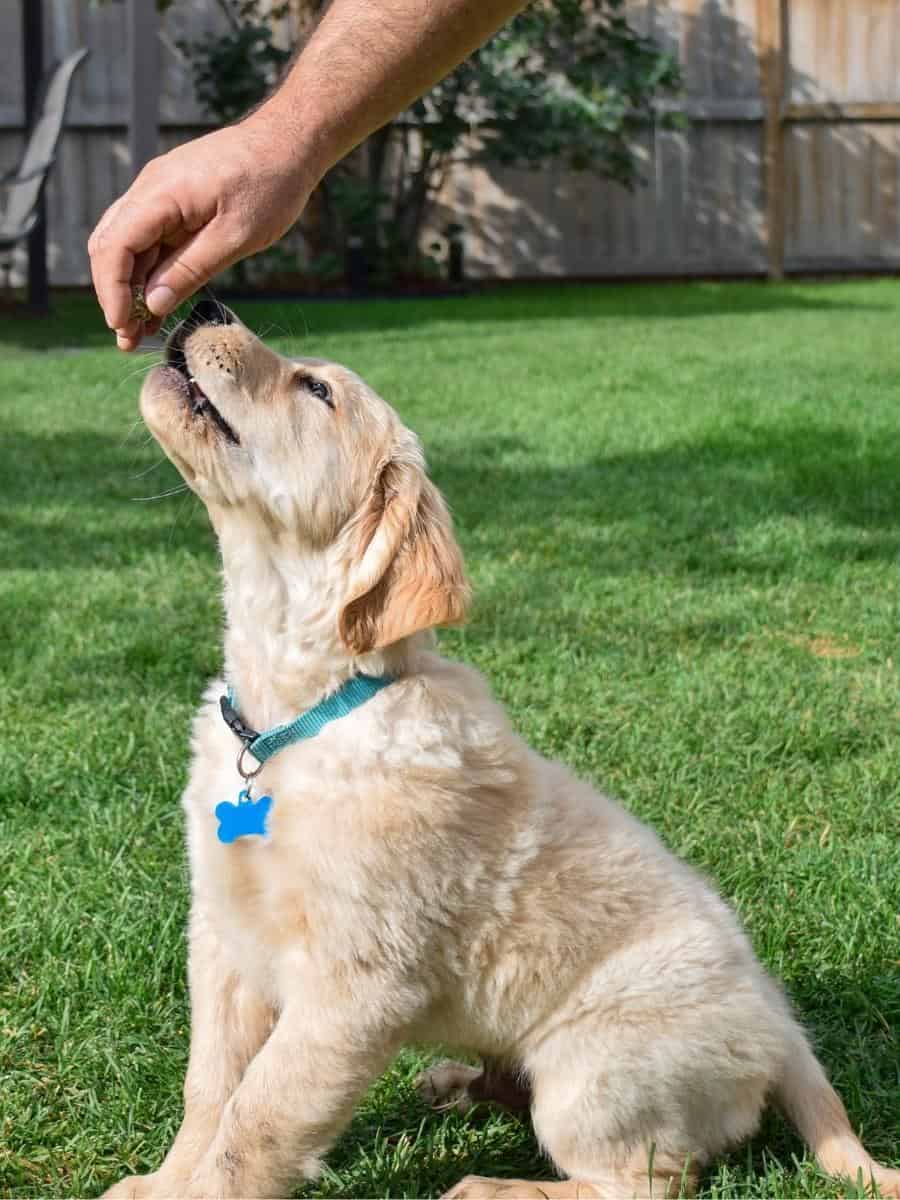
Activate Anchors – Start Recall Training
From the moment the puppy is released, you’ve been busy establishing yourself as the authority and anchoring different commands. The anchoring process involves saying something or making a specific sound while your dog is busy holding a certain position or acting a certain way.
Now is the time to start saying the words you have associated with his actions in order to inspire said actions.
Where you previously whistled when your Retriever ran towards you, now you must whistle so he begins his run. You are training your 3-month-old Golden Retriever puppy to associate the whistle’s sound as your command for him to run towards you. This is the start of his Golden Retriever recall training.
It is possible that your Retriever does not respond to the commands. Don’t be disheartened because these command triggers are not meant to work immediately. There will be back and forth where you will keep saying words while the dog organically acts.
You might get him to sit by saying, “sit.” But if he doesn’t sit, you can say the word when he sits and give him a treat. After a few attempts at reinforcing the commands, you can test the triggers again.
“My dog took 12-18 months to make a striking improvement in her recall. So avoid forcing your dog to be perfect on the first few attempts.”
If you discover that your Golden Retriever isn’t responsive when you activate the triggers, you should continue re-establishing the anchors and try again after another few days.
Build Comfort With Crowds – Work on Socialization
By now, your Golden Retriever is trained to acknowledge your friends and family. This helps him be social and get close to them. He must learn to be safe and social around strangers too. After all, he has to go on walks without picking fights with people, no matter how friendly Golden Retrievers are known to be.
Slowly exposing him to crowds can improve his social tolerance. The less quick he is to bark at strangers, the kinder they will be to him. This triggers a positive feedback loop where he is adored for being social, which encourages him to be more social.
Teach Your Golden Retriever Target Training
Teach your Golden to ask for treats! Here I use the word ‘treats’ loosely. Whether it is a cuddle, a pat, attention, or something tasty, you must teach your pup target training, for example, to touch a target with a specific part of his body. Remember that your Retriever may end up biting or clawing to communicate if you do not teach him more acceptable communication methods.
Here, I recommend teaching your Golden Retriever to touch your hand with his nose. While you’ll actively encourage him by holding out your hand, he will soon learn to softly connect your hand with his nose when you’re sitting.
Ultimately, this is an excellent replacement for bites! Hand targeting is fun to teach, helps your pup build trust, and gets him using his brain.
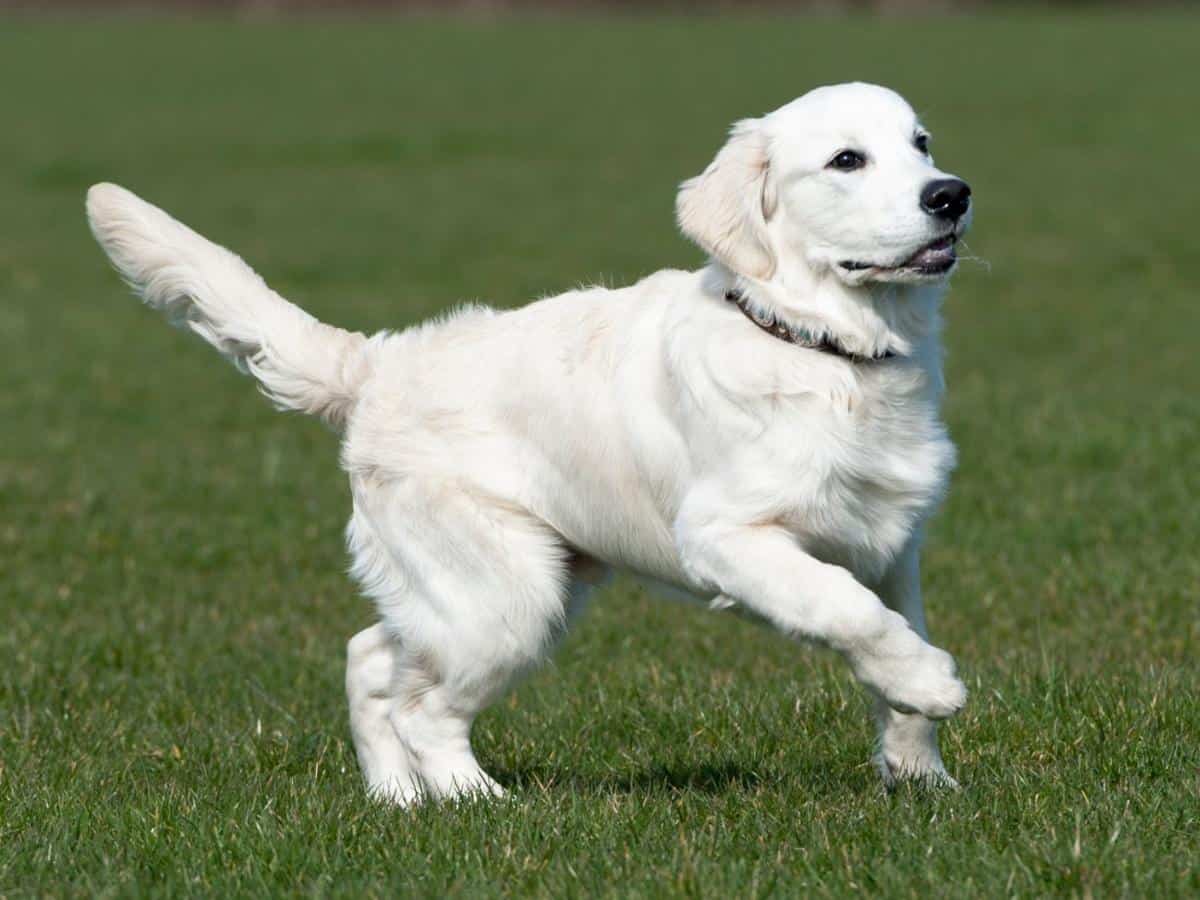
How to Train a 4-Month-Old Golden Retriever Puppy
Crossing the fifteen-week threshold means your Golden Retriever is ready for some ‘big boy’ training. You have laid a strong foundation of discipline and positive reinforcement, making it easier to train your dog to follow more difficult commands.
In these weeks, you will introduce him to assuming different positions, obeying your commands as he moves away from you, and reacting to more nuanced anchors.
Remember, 4-month-old Golden Retriever pups have a short attention span, so avoid prolonged training sessions.
Teach the Sit and Stay
Teaching your Golden Retriever to sit and stay is a valuable command for him to learn. He’s already learned to sit for a reward, but you can now progress this by training him to stay, ensuring he keeps his eyes focused on you at all times.
However, don’t expect too much too soon, as this can be difficult for your pup to grasp at first. Start by getting him to hold his “SIT” for a few seconds and gradually increase.
Train Your Dog to Fetch
If you have taken your Golden Retriever to public parks and he has seen other dogs play fetch, it will be easier to teach him to retrieve whatever you throw. You can take one of your dog’s favorite toys and throw it at a short enough distance. Your Golden Retriever may not bring the toy back to you for a second round, but he will soon get the idea of retrieving it.
You can gradually turn it into a game of fetch over the next few weeks and reward your pup with high-value training treats. Don’t forget; your Golden Retriever has it in his genetic code to master “FETCH!” in no time at all!
Continue Potty Training
In the fourth month of Golden Retriever training, you will continue potty training with a degree of independence. Teach your dog not to make a mess by rewarding him every time he doesn’t make one! Continue with a good schedule and sync your walks with his natural cycle to align with the times he needs to go.
Teach Your Golden Retriever to Walk on the Leash
Walking outdoors on a leash is a fundamental part of dog training. You can use it to control your Golden Retriever and later to test his ability to execute a command off-leash. A harness is also an excellent idea and is used for outdoor training and walks.
Many owners will opt for a rear-attached harness. However, I prefer a front-attached harness such as the Walk Your Dog With Love harness. It’s the harness I use for far less pull and greater control.
Your dog will find it extremely frustrating to pull with this harness as the front clip causes him to walk by your side; and if he tries to pull, he will end up rotating toward you. It’s also reasonably priced, with various colors and styles to choose from. You can check out my owner’s review here.
How to Train a 5-Month-Old Golden Retriever Puppy
A five-month-old Golden Retriever puppy is ready to be tested for his general obedience and the ability to deal with distractions, whether other dogs, people, or other animals, such as squirrels or birds.
A simplification of previous months’ training would be that you have sufficiently socialized your dog and trained him to recognize and associate personal affection, attention, toys, walks, and food as rewards.
Reinforce Previous Training
Now is the time to use the above as a reward and reinforce previous training while introducing distractions and prolonging your dog’s wait before gratification.
Earlier, I mentioned that you could not expect an eight-week-old puppy to delay gratification. Your puppy can deal with distractions at five months old if you introduce them slowly.
Contain His Energy
At five months, your Golden Retriever’s physical energy finally catches up with his enthusiasm and curiosity. You must be prepared for your dog to run ahead of you now!
However, suppose you have developed a solid relationship with your pup and worked on his training. In that case, he will stay within a reasonable distance, remain by your side, and show loyalty.
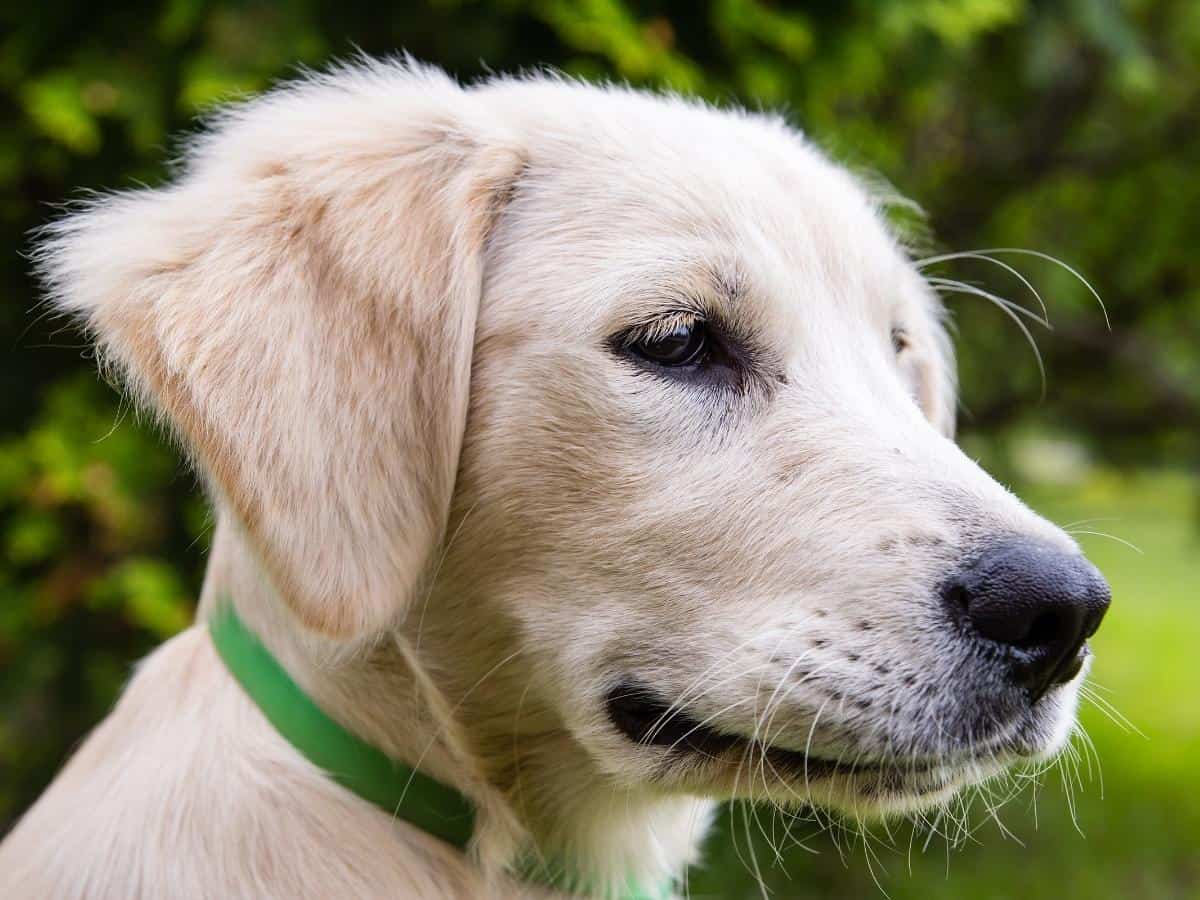
How to Train a 6-Month-Old Golden Retriever Puppy
This is the final month to call your puppy a puppy as he moves into his “teenage years!” He is now officially an adolescent. Once your Retriever puppy has reached his 6-month milestone, it also marks the point where you introduce him to advanced obedience training. The good news is that all the training you have previously given will make it easier for your dog to follow your lead.
Conclude Potty Training
Your dog has had months to learn how to communicate his need to go potty. He has also likely refined the patience to hold it instead of relieving himself on the floor.
Therefore, you can communicate your disappointment with your body language if your dog makes a mess. Avoid physical punishment and verbal chastising, as it negatively impacts your dog. All dogs can still have the odd accident up to 12 months old.
Additionally, you must be prepared for your dog to relieve himself indoors if he is excited or frightened. This is known as canine excitement or submissive urination.
Increase Exercise
Now that your Retriever puppy is six months old, you can increase his exercise to thirty minutes twice daily. Energy levels, especially for larger breeds, escalate during this time.
While the average exercise for a pup before this is generally five minutes of exercise per month of age, twice a day, a six-month-old Golden Retriever can be out for one hour if you split his walks into thirty minutes a day.
Advanced Command Training
This is also the time to focus on your dog’s advanced training. To train your 6-month-old Golden Retriever puppy, start with two commands with the most practical use. “LEAVE IT!” is the command that instructs your dog to stop holding onto whatever he is biting down on. This is useful when he grabs hold of something he shouldn’t and is a powerful way to instill discipline.
The second command you need to train your dog is the “WAIT!” command. As mentioned earlier, you’ll exercise your Golden Retriever a lot more now. If your pup runs far ahead, the “WAIT” command can help you catch up!
From six months onwards, until your Golden Retriever is a well-trained adult, you can teach the following commands or tricks in any order.
How to Train a 7-Month-Old Golden Retriever
As your Golden progresses to seven months old, a lot of the previous training needs to be kept consistent as you gradually teach him to figure out more commands.
I recommend adding up to two cues to your Golden Retriever’s training every month. But if he struggles to grasp a particular technique, continue working at that particular one until he has mastered it.
“TAKE IT!”
You can train your 7-month Golden Retriever to take things from your hand or pick something up, following any appropriate command. While most people resort to “TAKE IT!” you may want to use different words so your dog isn’t confused when you use “take it” in everyday conversation.
“SPEAK!”
You command your Golden Retriever to bark or be vocal. Maybe there is a trespasser, and you want your dog to scare them away. This is great to teach your Golden Retriever, as they don’t make good guard dogs due to their friendliness!
How to Train an 8-Month-Old Golden Retriever
Your 8-month-old Golden Retriever is ready to learn even more commands. You will need to continue training your dog to hold things or release them on command, but you can also proceed to add distance and even more background distractions.
“QUIET!”
You can train your dog to stop barking on command. Ironically, you need to teach him to bark on command before learning to be silent on cue.
Continue using the word “SPEAK!” as a trigger and do something that leads him to bark naturally. You will strengthen the association between the word “speak,” and your dog’s barking by giving him a reward.
Once your dog stops barking, say the word “QUIET!” Reward him with a treat and give lots of praise at the precise moment that he stops barking. Over this month, he will learn to associate the respective commands with barking and silence.
This is tricky, but your Retriever will eventually learn if you practice and remain consistent.
Different Commands for Different Places
Usually, “BED!” is the ideal command to teach a dog to go to his bed or crate on cue. The 8th month is perfect for training your Golden to go to different places upon hearing the command word.
This could be for practical reasons or to fully use your dog’s intelligence. Either way, do not overload him with ‘place’ commands; stick to no more than two per month.
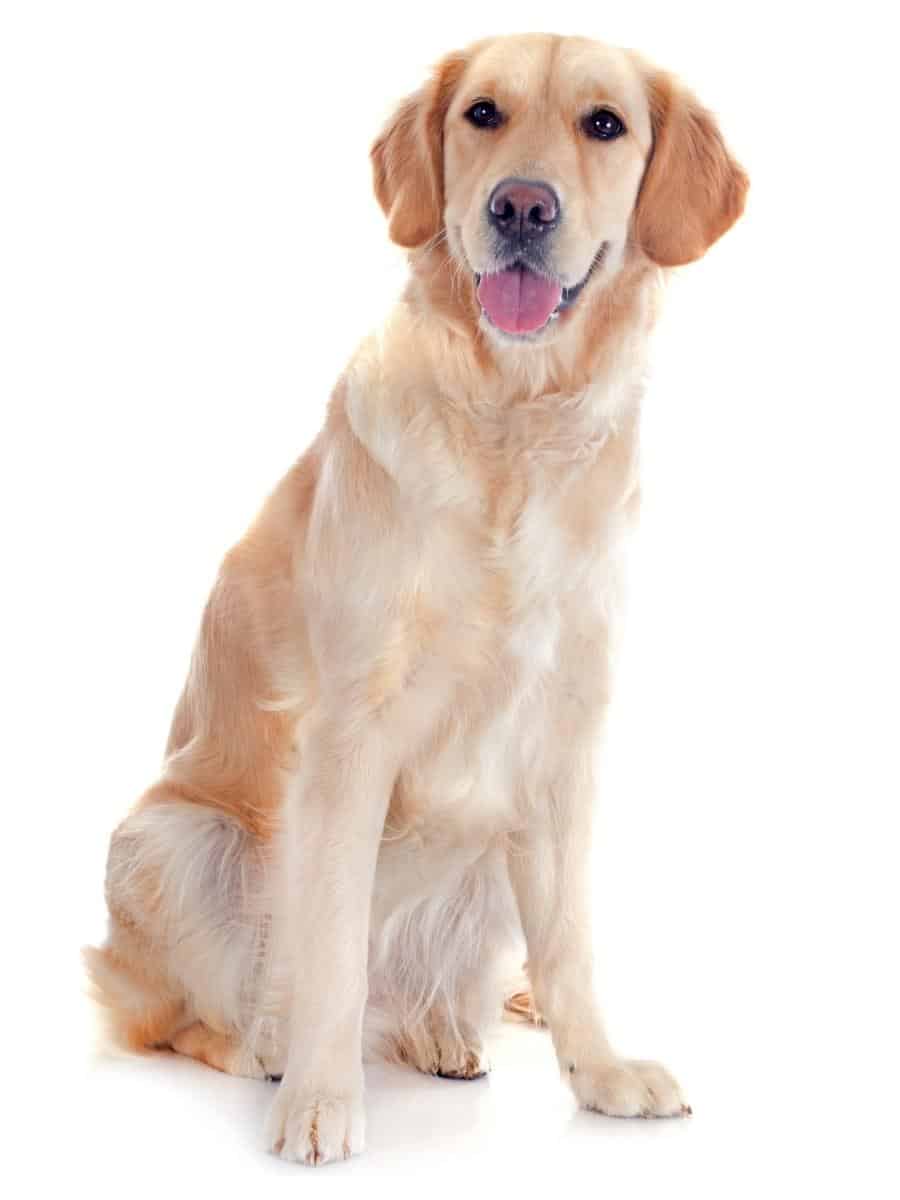
How to Train a 9-Month-Old Golden Retriever
If you find the training you’ve conducted over the last month beneficial, you can easily continue adding more places to your dog’s comprehension. Or you can use the ninth month to teach a cool party trick!
Teach Your Golden Retriever to Spin
By dangling a treat in front of your Golden Retriever and moving it in a circle till he’s spinning, you prime him for a command anchor. You associate the reward with this anchor by saying “SPIN!” and offering a treat.
After a week, you can remove the treat and teach your Golden Retriever to follow your finger. Of course, you will still need to reward him after he follows the command. By the third week, you can cue your dog to spin and see if he does so without your finger guiding him in a circular motion.
It might take an extra week or two, but I recommend this as an addition in the ninth month because it allows you to continue training your pet to learn previous commands better. You can teach him to go to different places, hold or release objects, and fetch toys.
How to Train a 10-Month-Old Golden Retriever
Even in the tenth month of your Golden Retriever’s training, you must constantly reinforce previous commands. I recommend adding only a simple “ROLL-OVER!” trick to his repertoire in the following month.
Your Retriever has already mastered the “DOWN!” position at 3 months old. You can now progress this further and teach him to roll over on command. Like teaching “SPIN,” use high-value treats with tons of praise.
How to Train an 11-Month-Old Golden Retriever
This is the last month before your Retriever’s first birthday! Use this time to teach your 11-month-old Golden, “GO AHEAD!” You direct your dog to stay ahead of you, the opposite to “WAIT!” This is also used in agility competitions to command your dog to go ahead of you.
How to Train a 1-Year-Old Golden Retriever
While the one-year milestone might seem significant from a human’s perspective, your dog’s capability to internalize commands and learn to follow cues doesn’t change drastically past this threshold. Your 1-year-old Golden Retriever only learns to comprehend more at the same pace as he has since the 6-month mark.
What does change is the fact that your dog is going to interact with other people more often. To keep him from simply barking for others’ attention, you can train him to do more tricks to give him a more attractive presence.
“CRAWL!” and “WAVE!” commands are perfect for this period. You should also audit previously taught commands and see any weak associations you can reinforce. Heck, you can even train your Golden Retriever to grab a beer! Watch how in the awesome YouTube video below.
How to Train an 18-Month-Old Golden Retriever
You will not have to alter your training regimen dramatically if you have trained your Golden Retriever properly from eight weeks onward. If anything, this is the period where you customize his training to your convenience. Up to this point, you have learned patience, altered your routine, and even made friends to accommodate your pet’s growth and education.
Now is when your dog must learn to be compatible with your life. From the 18-month mark onwards, you must train your dog to be harmonious with modern adult life (within reason).
It is sad to see dog owners having to give away their pets because of behavior issues. Such things are avoidable if you train your dog properly and exercise him sufficiently.
It is also possible you’ve come across this article having adopted an older dog. If you have an 18-month-old Golden Retriever who doesn’t seem to have previous training, don’t panic!
It would be best if you established authority by having a positive yet commanding presence. Once your dog acknowledges your authority and sees you as a guide, you can merely treat him as a six-month-old, albeit on an accelerated schedule, and train him accordingly.
Let’s Wrap This Up
Golden Retrievers are among the smartest dog breeds, which is why they are pretty trainable, provided you start early. If you establish authority and set anchors from the 8-week mark in their development, you’ll find that training them is easy.
With the month-to-month Golden Retriever puppy training schedule covered in this article, you will help your dog realize his potential to be an obedient, socially compatible, and compassionate companion.
Related Posts You May Like:





